|
|
| i saw a lot of renderings with radiosity and hdr and i read a lot of
tutorials about the usage of hdr and radiosity. and sometimes i'm really
surprised about the things people thinking and doing. i saw often too much
reflections, wrong reflections, too less contrast and last but not least,
renderings with a background picture instead of a hdri. sometimes it was a
little bit 'radiosity just to use radiosity' or 'radiosity only for the
look' (you know that clay like stuff with this nifty noise spangles all
around) so what's the problem with hdri lighting? i think the first big mistake is to switch from classical lighting to hdri lighting without thinking about the nature of light and the behavior of hdri lighting. this is based on several things. reflections, diffuse, overall brightness. it took me a while to figure out why some of my renders (and others) are not like i want. i used a hdri and reflection gradients, photo textures, depth of field and all this stuff but it was not like the original. so i will start to explain the details now. | |
| i will compare this procedure with a photography of an object. since lightwave is able to produce high dynamic renderings with the floading point render engine it is easy to tweak the result after rendering the image. we don't have to care about overall brightness at the first steps. so let's begin with the first important thing - reflections. we don't talk about metal reflections now i mean such things like dark plastic or ceramic stuff. if we take a look at our enviroment we'll see many things are defined by reflections. since dark materials absorbing nearly every light hitting the surface they are only visible because of the reflections or in comparison to brighter materials. | 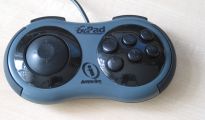
|
| since we don't use glossiness (it's only for the reflection of invisible light sources) with hdri lighting the reflections of lights are only adjusted by the amount of reflection of the surface. if you take a look at a photography you will see that the reflection of a window is over exposured because the exposure is measured for the whole scene (for example, not generally) and so the window is too bright. if you adjust the reflection of the surface to get a good reflection of the window you will have only a small reflection of the enviroment and nothing more. that's wrong. let's check the following pictures, we can see that the whole room is visible on the black and shiny parts of the controller. | 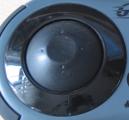
|
| if we say we have around 2-3 percent reflection at an incidence angle of 90 degree we have to tweak the enviroment that way that we'll achieve the same reflection on our model. we don't have to spend too much attention to the parts where we look with a very flat angle onto the model because 'mr. fresnell' will do the trick for us (add a nonlinear gradient for the reflection layer or use a fresnell shader). after a first test rendering we'll see that there is nothing to see on our model. that's bad, indeed, and the reason for that is - our hdr is too dark. many hdri's and mine too are adjusted to get a good visual expression. nobody want to see an over exposured picture. since we know the amount of reflection is given by nature and we don't want to change the hdr there is only one way for that - we have to increase the brightness using the image world plugin or with the amount of radiosity. the latest option might work well for backdrop lighting but can produce strange effects if we want to use monte carlo. if you have only minor radiosity effects in your picture and want more, then use this option too. | 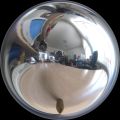 |
| after changing the brightness and a test rendering we'll get a helluva
bright picture. the reason for that is simple. as long as we used 'normal'
lights withing lightwave we adjusted the surfaces to get nice results with
lights between 0-100 'lightwave units'. but a hdri uses a big range for
the light and after increasing the brightness we have lights with an
intensity of 1000 or more. this ain't good for our surfaces. |
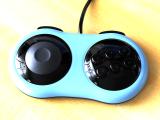 |
| so we have to lower the diffuse value of our surface until it matches
the expectation. unfortunately we have to change the reflection value a
little bit. a natural surface 'should' have 100% reflection at a view
(incidence) angle of 90 degree but this reflection is the total amount of
total reflection and diffuse reflection. since we simulate the diffuse
reflection with the diffuse parameter the reflection is too heavy.
decrease the reflection a little bit. the picture on the right side is
close to our original. it's not the same hdr, i shot the photo later and
the controller is not the same. the reflection blurring produces light
bulb on the left which is too big. you can try to change this with
decreasing the reflections or adding a gradient to the diffuse value to
use a lower diffuse value for an incidence angle of 90 degree. |
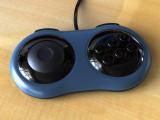
|
| here now the settings: image world brightness: 300% global illumination: ambient light - 0, radiosity - backdrop only - 100% - 12x36 surface data: main body of the controller: diffuse - non linear gradient, incidence angle, 0 degree - 35%, 90 degree 20% (this will increase the affect of light to the surface) reflection - non linear gradient, incidence angle, 0 degree - 65%, 90 degree - 6% (the 0 degree value should be 100% but that's not correct for lightwave since we use diffuse too) shiny parts except buttons: diffuse 0, because the surface is black, reflection - non linear gradient, incidence angle, 0 degree - 100%, 90 degree - 4 % the other parts are nearly the same but with additional fractal noise for bump and a bump map for the numbers on the buttons. |
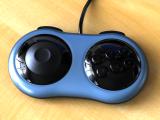 |
| the picture is too perfect so feel free to tweak the surface with some dirty maps to add tiny adjustments to the reflection maps (use substract for blending mode). also the color range and the contrast is compared to a photography too good. and, the textures ;-) | |
| if you are looking for high quality hdri images from very different
locations, optimized for the usage of product lighting feel free to check
out http://www.realtexture.com/ for a complete and
affordable cd full of hdri images. thank you for reading this tutorial and if you have any comments, suggestions or questions feel free to email me at tut@dbki.de |
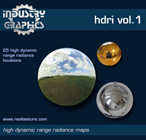 |
| related links: compositing and hdri hdri and backgrounds speed up hdri renderings http://www.dbki.de/index.html tutorial index at dbki |